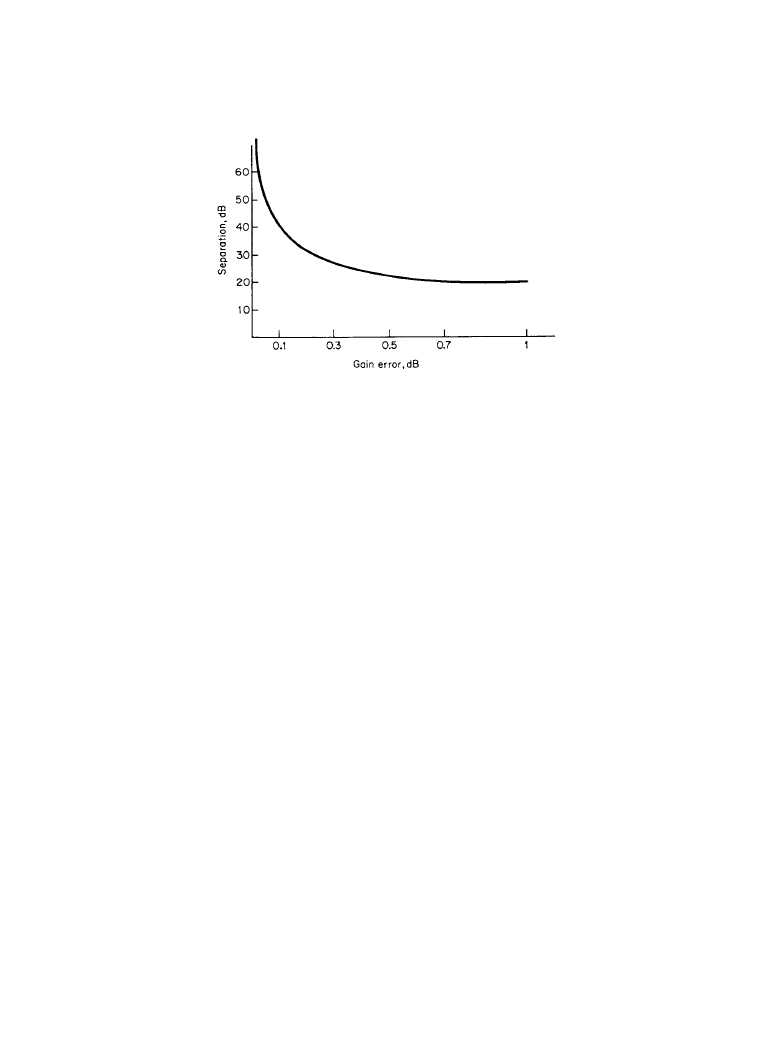ВУЗ: Казахская Национальная Академия Искусств им. Т. Жургенова
Категория: Книга
Дисциплина: Не указана
Добавлен: 03.02.2019
Просмотров: 21598
Скачиваний: 19

Stereo Television 12-83
especially since the SAP is 10.5 dB below L – R and the PRO is 20 dB below L – R. Generator
spurious suppression should be greater than 75 dB below 100 percent L – R.
Deviation Calibration
Unlike noncompanded FM stereo, the BTSC system requires precise adjustment of aural-devia-
tion calibration for optimum received stereo separation and frequency response. Like some tape
noise reduction systems, the encoder-to-decoder levels must be carefully matched for good sys-
tem performance. For example, an aural-deviation error of 1 dB will degrade separation from
perfect to less than 20 dB (Figure 12.4.5). The stereo generator should incorporate a deviation
calibration system that allows the aural deviation to be quickly and easily set and checked with
an accuracy of better than 1 percent.
12.4.2d
Composite STL Specifications and Performance Objectives
To maintain a system separation greater than 40 dB, the composite amplitude response must be
within ±0.08 dB and the composite phase response must be less than ±1° from linear phase over
the band from 50 to 47,000 Hz.
If a SAP or PRO signal is to be added, the composite amplitude and phase response must be
flat (±1 dB, ±10°) to 120,000 Hz to prevent crosstalk.
Signal-to-Noise Ratio
The FM signal-to-noise ratio of the STL should be better than 65 dB (unweighted) with 75-
µs
deemphasis.
Distortion
The aural composite STL should have distortion of less than 0.1 percent. Any distortion of the
baseband signal caused by the STL will have secondary effects of the stereo, SAP, and PRO
Figure 12.4.5
Stereo separation as a function of composite gain error.
Downloaded from Digital Engineering Library @ McGraw-Hill (www.digitalengineeringlibrary.com)
Copyright © 2004 The McGraw-Hill Companies. All rights reserved.
Any use is subject to the Terms of Use as given at the website.
Stereo Television

12-84 Radio Receivers
crosstalk, which is quite noticeable at the receiver with rather small amounts of distortion added
to the baseband. For example, an increase of baseband harmonic distortion from 0.05 to 1.0 per-
cent will increase crosstalk into the SAP by as much as 26 dB.
Amplitude Stability
The encoded TV stereo composite signal is highly sensitive to gain variations in the composite
path. As shown in Figure 12.4.5, a gain error of less than 10 percent (1 dB) will reduce the sys-
tem separation to less than 20 dB. This assumes that the separation was perfect before the gain
error was introduced. For good separation, the composite path should have a maximum gain drift
of ±0.2 dB over time and temperature.
12.4.2e
Aural Exciter Specifications and Performance Objectives
To maintain a system separation greater than 40 dB, the composite amplitude response must be
within ±0.08 dB and the composite phase response must be less than ±1° from linear phase over
the band from 50 to 47,000 Hz and over an aural carrier deviation of 50,000 Hz. If a SAP or PRO
signal is to be added, the composite amplitude and phase response must be flat (±1 dB, ±10°) to
120,000 Hz to prevent crosstalk.
Signal-to-Noise Ratio
The FM signal-to-noise ratio of the aural exciter should be better than 65 dB (unweighted) with
75-
µs deemphasis.
Amplitude Stability
As outlined previously, the encoded TV stereo composite signal is highly sensitive to gain varia-
tions in the composite path. For good separation, the aural exciter should have a maximum gain
drift of ±0.2 dB over time and temperature.
12.4.3 References
1.
Eilers, C.: “The Zenith Multichannel TV Sound System,” Proc. 38th NAB Eng. Conf.,
National Association of Broadcasters, Washington, D.C., 1984.
2.
Federal Communications Commission: Multichannel Television Sound Transmission and
Audio Processing Requirements for the BTSC System, OST Bulletin 60, FCC, Washington,
D.C.
3.
Electronic Industries Association: Multichannel Television Sound—BTSC System Recom-
mended Practices, EIA, Washington, D.C., ETA Television Systems Bulletin 5, July 1985.
4.
Mendenhall, Geoff: “Testing Television Transmission Systems for Multichannel Sound
Compatibility,” Proc. 39th NAB Eng. Conf., National Association of Broadcasters, Wash-
ington, D.C., 1985.
5.
Buecklein, R.: “The Audibility of Frequency Response Irregularities,” J. Audio Eng. Soc.,
vol. 29, no. 3, pp. 126–131, March 1981.
Downloaded from Digital Engineering Library @ McGraw-Hill (www.digitalengineeringlibrary.com)
Copyright © 2004 The McGraw-Hill Companies. All rights reserved.
Any use is subject to the Terms of Use as given at the website.
Stereo Television

Stereo Television 12-85
6.
Plenge, G. H., H. Jakubowski, and P. Schoene: “Which Bandwidth Is Necessary for Opti-
mal Sound Transmission?,” presented at the 62d Convention of the Audio Engineering
Society, Brussels, March 13–16, 1979.
7.
Snow, W. B.: “Audible Frequency Ranges of Music, Speech and Noise,” J. Acoust. Soc.
Am., vol. 3, pp. 155–166, 1931.
Downloaded from Digital Engineering Library @ McGraw-Hill (www.digitalengineeringlibrary.com)
Copyright © 2004 The McGraw-Hill Companies. All rights reserved.
Any use is subject to the Terms of Use as given at the website.
Stereo Television

Downloaded from Digital Engineering Library @ McGraw-Hill (www.digitalengineeringlibrary.com)
Copyright © 2004 The McGraw-Hill Companies. All rights reserved.
Any use is subject to the Terms of Use as given at the website.
Stereo Television

13-1
Section
13
Standards and Practices
A widely used dictionary lists seven meanings for the word “standard,” but only one of these,
“anything authorized as a measurement of quantity and quality,” seems to relate to the idea of a
standard in the industrial area. The original idea of commercial standards was to be bound legally
on units of weights and measure for fairness in trade. In the field of electronics, the standardiza-
tion of electrical units of measurement would be the counterpart. Today, standards are essentially
recommendations for users and/or manufacturers to adhere to basic specifications to allow oper-
ational interchangeability in the use of equipment and supplies.
Anyone concerned with interchangeability of equipment or product should be concerned with
standards. A prospective user hesitates to purchase equipment that does not conform to recog-
nized interface standards for connectors, input/output levels, control, timing, and test specifica-
tions. A manufacturer may find a limited market for a good product if it is not compatible with
other equipment in common use.
To most audio professionals, the term “standards” envisions a means of promoting inter-
change of basic hardware. To others, it evokes thoughts of a slowdown of progress, of maintain-
ing a status quo—perhaps for the benefit of a particular group. Both camps can cite examples to
support their viewpoint, but no one can seriously contend that we would better off without stan-
dards. Standards promote economies of scale that tend to produce more reliable products at a
lower cost.
For most people, the question is: “How do standards affect my life? Do they stifle progress?
Do they prevent products from appearing on the market in a timely fashion? Do they discourage
alternate technologies that might be beneficial in the long run?” Many would respond affirma-
tively to one or more of these questions, but consider the upside. Standards ensure that the needs
of the user are considered. Interconnection of equipment from different manufacturers is facili-
tated. The current rollout of digital audio products at a record pace attests to the need for stan-
dards. The progress made so far in the digital era would have been wholly impossible without the
considerable efforts of organizations such as the AES, ATSC, SMPTE, SCTE, and NAB.
Rapid improvements in technology tend to make many standards technically obsolete by the
time they are adopted. But such is the nature of our rapidly expanding technology-based society.
There is no need to apologize for this natural phenomena. A standard still provides a stable plat-
form for manufacturers to market their product and assures the user of some degree of compati-
bility. Technical chaos and anarchy are real possibilities if standards are not adopted in a timely
Source: Standard Handbook of Audio and Radio Engineering
Downloaded from Digital Engineering Library @ McGraw-Hill (www.digitalengineeringlibrary.com)
Copyright © 2004 The McGraw-Hill Companies. All rights reserved.
Any use is subject to the Terms of Use as given at the website.